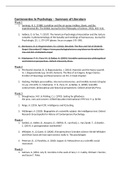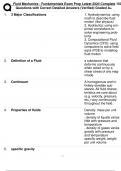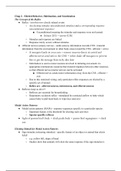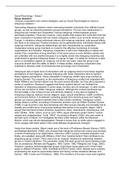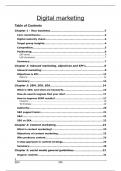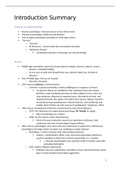Lectures & Tutorials
Important terms (treaties, policies)
Important economic/law terms
Lists of important stuff
Extra notes about something non-substantively
ECON .
Lecture 1A: Introduction 30-03-2020 (only lecture missing)
Lecture 1B: Economics of the Customs Union 31-03-2020
Economics study the world in a particular way. (Macroeconomics)
- They assume people make rational decisions
- and they exchange on markets
We can read various treaties to study the history of economy, because they are
writing down the economic constitutions (or constitutional moments) of Europe (legal
documents). Wrote down the economic rules that were governing in Europe.
First stage of European Integration: Treaty of Rome (1957):
Treaty Establishing the European Economic Community.
So a founding moment for European integration
Look as an economist to Treaty of Rome:
- economic constitution for European integration
- economics of customs union
Built on Treaty of Paris (1951) establishing the European Coal and Steel Community:
- common market for coal and steel
Three Clips (of this lecture):
A - Economic Constitution of the Customs Union
B - Apply the Economic Approach: Introduction to Welfare Analysis
C - Welfare Analysis of Customs Union
A: Economic Constitution of the Customs Union
“Economic constitution” in treaty of Rome:
- Establishing a common market
- Progressively approximating the economic policies of member states
,Goals of these measurements:
1. Promote throughout the Community a harmonious development of economic
activities
2. A continuous and balanced expansion
3. An increase in stability
4. An accelerated raising of the standard of living (economic growth)
5. Closer relations between the states belonging to it
legal framework for establishing economic cooperation in Europe by Pelckmans:
Treaty of Rome. Economics mostly look at the low part of the systematic table.
(common market + approximating economic policies)
To establish:
- Customs Union (CU): with free movement of goods, services,
labor and capital. [market / negative integration = taking away the barriers].
So no taxes (import and export tariffs, quota) anymore between European
countries among other restrictions.
- with supporting economic policy [policy / positive integration], eg.:
→ Common Agricultural Policy (CAP)
→ European Competition Policy: See Weblecture L.E1c
If you want to have a common market, you need rules for how you’re gonna trade on
these markets! → Policies.
,Agricultural trade was a very specific part because people always want to protect
their own food: Especially in times of war or like now coronavirus.
So market integration and policy integration went hand in hand.
Which again means that economic integration and political integration go hand in
hand. Economic integration will not work if there’s not enough political integration.
Stages of Economic integration by Balassa (1961)
With the treaty
of Rome we
skipped stages
and
immediately
went for the
Common
Market
Customs union:
- Abolish (import/export) tariffs for partner countries
- Imposing a common external tariff for third countries
Quota: A maximum allowance of import/export. F.a. You can only import 100.000
cars a year.
Economic questions about decision to institute a customs union:
1. What was the economic context of this decision to integrate?
● Why decide to institute a customs union?
2. What are the economic implications/impact of this decision to integrate: what are
economic benefits?
● Does a customs union bring economic benefits? And who is benefitting?
Because everything we do in economic arrangements we have winners and
losers. Some people will have bigger benefit than others.
In order to answer these questions we have to use an economic tool: welfare
analyses.
, B: Apply the Economic Approach: Introduction to Welfare Analysis
The economic approach:
1. Individual rational choice
2. Exchange on markets
3. Effects for economy as a whole
To analyze economic effects of customs union, we use a basic economic technique:
Welfare analysis
→ To understand Welfare Analysis, we need to start with the core model of
economics: the market
Market: Model of Supply and Demand
Competitive market: many buyers and many suppliers
Graphic representation of market (competitive market):
❏ One good (for example concert tickets)
❏ Demand for good: Demand Curve (D: going Down, VRAAG)
❏ Supply of good: Supply Curve (going Up, AANBOD)
❏ Equilibrium price: price at which quantity demanded equals quantity supplied:
market clearing price (waar vraag en aanbod samenkomen)
vertical: price
horizontal: quantity
Demand curve: definition:
Relationship between Price and Quantity
Demanded: Graphic representation of
amount consumers are willing to buy at
a certain price.
1. Demand Curve represents the
demand side of market (consumers)
2. Representation of ‘what the people
want’ at varying prices
Supply Curve: definition:
Relationship between Price and Quantity Supplied:
Graphic representation of amount producers are able to supply at a certain
price.
1. Supply curve represents the supply (producers) side of markets
2. Representation of costs of production

